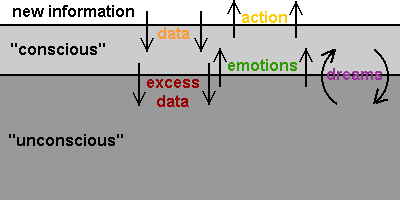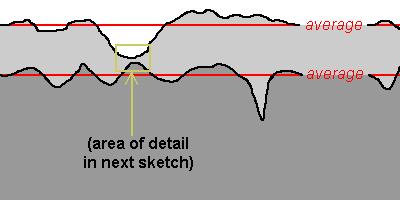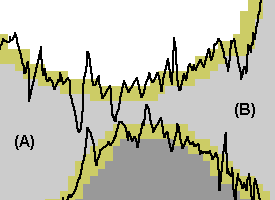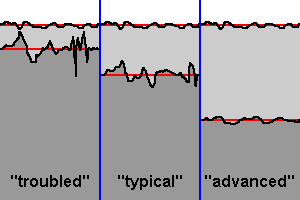|
(what's the point?) This is an interesting little model that has sort of drifted into my thoughts. I have been thinking about dreams, rationality, and emotions a lot recently, and their relationships to our conscious mind and the things we are unconscious to. So this might be a piece on the mind, or dreams, or emotions, or rational thought and living... I'm not sure, really. I hope this little series of sketches and their explanations helps you see what I am up to, and perhaps even helps me figure it out myself! I suppose first a quick definition or two will be in order. 1. The "conscious" mind is everything that you are ever able to bring to the fore in your thoughts, in any way whatsoever. Even some distant memory that is only triggered by a special smell, is still a conscious, accessible thought. 2. The "unconscious" mind is that mass of memories and information and learning which is not ordinarily accessible to our thoughts, but might very well influence our mental states and our actions. 3. "Dreams" are those things that happen when we are asleep, those strange permutations and superpositions of events and activities from our life. 4. "New information" of course includes straightforward sensory input, but also any fresh experience - for instance hunger, while not an external sensory input, is new information. We will include all inner "sensation" as well as that from the outer world. New information also includes our thoughts and feelings, our reactions to external stimuli, and even just the things we think and feel. This is all "fresh stuff" entering our conscious mind to be processed one way or another. I will mostly refer to it as "sensation" in this piece. 5. "Action" is what we do to the world as a result of our minds activities and states. 6. "Emotions" are irrational responses to stimuli - pleasant, unpleasant, or neutral, their main feature is that they cannot necessarily be clearly explained in terms of the things we think we think. They do not necessarily lead to action, of course, they may arise, play out and vanish all within the space of our thoughts. So, are we ready to play? Here is a neat little schematic of these things I have just defined:
To move vertically in these diagrams is to follow the flow of information, for instance a downward path would start out as a sensation. As it moves through the conscious mind, it is experienced, and stored away as memory. Parts of the experience that may be unfathomable, or simply never noticed, may head straight to the unconscious, where we have no idea what will happen to them - for now. They may be processed, clumsily, as dreams at some point in time, perhaps whne we have more information, or are better able to cope with them. In the meanwhile, the unconscious fragments may very well express themselves as emotional, or irrational, repsonses to future sensations which evoke them, or even shape our ability to handle totally unrelated experiences. The horizontal axis, or dimension, of this chart is sort of a neuronal thing - the wider a chunk you take, the more brain is involved, in a sense. The narrowest possible path would be what is required physically to "have a thought" as simple as possible. It may still represent patterns involving tens of thousands of neurons (but a tiny fraction of them!), or, again, may represent a very low level of awareness, perhaps many many neurons, but not firing rapidly or densely. A wider path might include many more or less related factors of your mind - a complex skill set, perhaps, or a very intense environmental situation. It is hard to know how to "group" these - especially in only one dimension. I suspect that to actually use this model to represent a map of the mind, it would have to be multidimensional in the direction that I have shown one single horizontal dimension in order to show the relationships between different mental states. But that is ok, since it is the vertical axis that I am exploring here, and that is why I made up these charts.
Well, I will try to share a few useful things I have learned about life that are illustrated well in these charts. Notice, if you will, that I have chosen the area to blow up for the third chart quite carefully. What is different about it from the nice neat averages and even the gently curving lines? The area I chose is one where the line representing the interaction between sensation and thought is very "low" - that is, the patient is very sensitive to this particular range of experience. Also, and more important for my topic here, the line representing the boundary between conscious thought and the unconscious is very high. There is almost no space in between the two lines. This particular section of the abstract patient's mind is one where the sensation as experienced has very little, if any, conscious processing between it and the patient's unconscious. This is a problem, which operates in two different ways. One is that raw sensation can make its way with very little mediation from the conscious mind into the patient patients unconscious (no "thinking things through"). The other is that the unconscious, in its irrationality and production of raw emotions, has very little rational thought to process and filter it before generating action by the long suffering patient. So here is the point I am trying to illustrate. Our heads are full of a lifetime's accumulation of information. Much of it is "buried" in the unconscious, even though there is still a vast amount accessible to the conscious mind. Every day we take in more data, and perform actions based on our past and the current environment. The actual nature of this "Huw Diagram," if it could somehow be drawn for your mind, would show the area in which you act least rationally (and are most emotionally vulnerable), the areas in which your mind is "strongest," and how they are related. It would be a clear illustration of your psychological (and to an extent, spiritual) health. It makes clear that a personal goal of improving your understanding of the processes in your mind where the conscious section is thinnest would be of paramount importance to moving the overall position of that "average" line. After all, what good is it to be able to deeply consider and calculate exactly what sort of house you want to buy (for instance), when you still fly into a rage every time someone calls you on the telephone unexpectedly? The more inroads you can make on those "high points" on the line between your conscious mind and unconscious, the more of your brain is available for your own, "willing" use, and the less your responses to situations will be irrational and poorly understood by you.
The "advanced" mind has much more "room" for conscious processing, enjoyment, and contemplation of its life. There are far fewer hair trigger points which precipitate crises due to thoughtless emotional reactions, and also fewer situations in which the person will suffer an increase of their unconscious baggage due to the "conscious insulation" which is pretty consistently interposed between the world of sensation and the unconscious mind. The peaks in the unconscious line, as they approach closely to the sensation line, also make it difficult for the mind to "share" within itself from one side of the narrowing to the other - since vertical segments of these diagrams represent functionalities, some of them may be quite isolated from others, since the only "crossing over" between them, or sharing of neuronal pathways, is very narrow in the conscious realm. Thus, as data is transferred horizontally through these regions, it may very well have to pass through the unconscious along the way, and lose all semblance of rationality or planned, conscious thought along the way. It may also equally be forced out into behavior, since the "outer world" of sensation is another "wider" pathway from (A) to (B). The subject has to act out their thoughts, and essentially re-experience them, in order to get them from one part of their mind to another! This is also rather undesirable - and I do not mean this as an external judgment, applying some kind of "norm" to the patient. It would be experienced as undesirable or unpleasant by them personally. That is the only valid judgment of behavior, in my opinion - for the subject to compare what they wish to be with what they actually experience themselves as. So how on earth is one to "push down the line" by narrowing and lowering these peaks of unconsciousness? (Although theoretically it is possible to "raise the line" to sensation, these lines are drawn relative to each other, and the variances in the sensation line merely indicate sensitivities to certain kinds of experience. Such mundane things as good or poor eyesight are not going to yield to inner-directed self actualization!) This is obviously the key question for the casual reader. (The key question for the serious reader is how can these diagram be created, read, and used at a clinical level) To narrow and lower these peaks. I think the best course of action is as follows. First, you must be reasonably used to observing your inner life, your thoughts, your feelings, your actions and reactions, your desires, your successes and your failures. This allows you to occasionally identify what may be a peak in your unconscious, as it interferes in your ability to live and act as you wish. The process of actually "getting up close" to a peak can be pretty uncomfortable - first you have to trigger the darn thing, which results in a high quotient of irrationality entering your conscious mind. The trick, as I see it, is at that point to try to engage your conscious, rational, skills - not to consider the issue that triggered the unconscious reaction, as that would only make things worse, but to consider the nature of the reaction itself. Take notice of what caused it to arise. As you think about the mechanism, keep "nearby" in your mind the causative factor so if you lose track of the irrational response, you can trigger it again, mildly one would hope. This enables you to keep reflecting on its structure. Be careful not to overdo it, as the triggering process can be painful. You do not want this to be an overwhelmingly uncomfortable experience, or you will form defense mechanisms (unconscious reactions) against this very process! Also take care to be in a quiet, unstressed environment for this process. It is also wise to give yourself time to recuperate after working on this before attempting to interact with others, especially those who might form part of this particular jigsaw puzzle in your mind. What this means, for example, is do not overwhelm yourself with an attempt to analyze your jealousy responses when your lover is on their way over to visit (unless the two of you planned to work on these issues, I suppose). You will be raw and still a bit irrational, and it is not fair to victimize others as a result of your attempts to improve your own mind. It is also my advice to enjoy your strengths - but work on your weaknesses. "Perfecting" an area in which you are already strong is nice, but it will not "push the line down" very much. It is already very low in this area. What matters is to take the energies and motivation and self esteem supported by those activities and invest it carefully in working on your weakest traits, the places where the sensation and unconscious lines seem to approach each other the closest. 1/1/02
© Huw Powell file location: www.humanthoughts.org/mind2.htm
|



